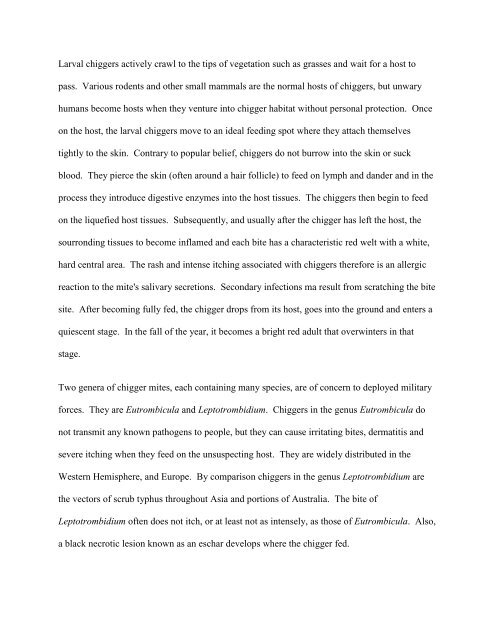Field Guide to Venomous and Medically Important Invertebrates ...
Field Guide to Venomous and Medically Important Invertebrates ...
Field Guide to Venomous and Medically Important Invertebrates ...
You also want an ePaper? Increase the reach of your titles
YUMPU automatically turns print PDFs into web optimized ePapers that Google loves.
Larval chiggers actively crawl <strong>to</strong> the tips of vegetation such as grasses <strong>and</strong> wait for a host <strong>to</strong><br />
pass. Various rodents <strong>and</strong> other small mammals are the normal hosts of chiggers, but unwary<br />
humans become hosts when they venture in<strong>to</strong> chigger habitat without personal protection. Once<br />
on the host, the larval chiggers move <strong>to</strong> an ideal feeding spot where they attach themselves<br />
tightly <strong>to</strong> the skin. Contrary <strong>to</strong> popular belief, chiggers do not burrow in<strong>to</strong> the skin or suck<br />
blood. They pierce the skin (often around a hair follicle) <strong>to</strong> feed on lymph <strong>and</strong> d<strong>and</strong>er <strong>and</strong> in the<br />
process they introduce digestive enzymes in<strong>to</strong> the host tissues. The chiggers then begin <strong>to</strong> feed<br />
on the liquefied host tissues. Subsequently, <strong>and</strong> usually after the chigger has left the host, the<br />
sourronding tissues <strong>to</strong> become inflamed <strong>and</strong> each bite has a characteristic red welt with a white,<br />
hard central area. The rash <strong>and</strong> intense itching associated with chiggers therefore is an allergic<br />
reaction <strong>to</strong> the mite's salivary secretions. Secondary infections ma result from scratching the bite<br />
site. After becoming fully fed, the chigger drops from its host, goes in<strong>to</strong> the ground <strong>and</strong> enters a<br />
quiescent stage. In the fall of the year, it becomes a bright red adult that overwinters in that<br />
stage.<br />
Two genera of chigger mites, each containing many species, are of concern <strong>to</strong> deployed military<br />
forces. They are Eutrombicula <strong>and</strong> Lep<strong>to</strong>trombidium. Chiggers in the genus Eutrombicula do<br />
not transmit any known pathogens <strong>to</strong> people, but they can cause irritating bites, dermatitis <strong>and</strong><br />
severe itching when they feed on the unsuspecting host. They are widely distributed in the<br />
Western Hemisphere, <strong>and</strong> Europe. By comparison chiggers in the genus Lep<strong>to</strong>trombidium are<br />
the vec<strong>to</strong>rs of scrub typhus throughout Asia <strong>and</strong> portions of Australia. The bite of<br />
Lep<strong>to</strong>trombidium often does not itch, or at least not as intensely, as those of Eutrombicula. Also,<br />
a black necrotic lesion known as an eschar develops where the chigger fed.

















